Introduction
This is the third report in an ongoing pilot study by COAR to monitor stability and social tensions in northeast Syria. Data collected and verified by COAR field researchers has been classified and analysed according to a broad set of indicators. This brief report assesses data collected in May 2021. As with the previous assessment of March and April data (see: Northeast Syria Social Tensions and Stability Monitoring Pilot Project – March and Northeast Syria Social Tensions and Stability Monitoring: April Update), this report aims to address several dynamics that shape the operational environment for donor-funded aid activities, stabilisation initiatives, and political and strategic decision-making concerning northeast Syria.
The three main dynamics assessed are Arab tribes’ efforts to increase their local autonomy; Islamic State (IS) insurgency; and the interaction between local communities and the Autonomous Administration and Syrian Democratic Forces (SDF). In response to developments in northeast Syria in May, this report considers the impact of the Autonomous Administration’s governance decisions on local stability, in particular in south rural Al-Hasakeh, where recent decisions have prompted widespread unrest. Also considered is the appropriation of the IS name and even its notorious flag, by independent actors seeking to achieve their own strategic objectives, unrelated to the group. All told, in May, the focal point of popular demonstrations against the Autonomous Administration shifted from the Arab-majority areas of eastern rural Deir-ez-Zor toward Kurdish communities in Al-Hasakeh, including Quamishli. This does not necessarily suggest that the Autonomous Administration’s legitimacy is diminishing among the Kurds, but it does demonstrate that economic deterioration and social vulnerability impact local stability, in addition to more readily recognised factors such as ethnic identity and historical relationships.
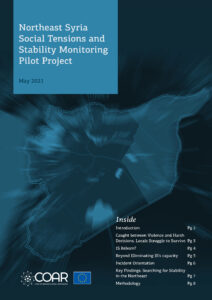
Caught between Violence and Harsh Decisions, Locals Struggle to Survive
Two significant decisions by the Autonomous Administration in May 2021 triggered shockwaves of dissatisfaction and outrage throughout northeast Syria, particularly in Deir-ez-Zor and Al-Hasakeh governorates. In the first instance, on 17 May, the Autonomous Administration instituted a major fuel price hike, raising the litre price of petrol from 150 SYP to 400 SYP and the price of cooking gas cylinders from 2,500 SYP to 8,000 SYP. Multiple people were killed as security forces cracked down on demonstrators who took to the streets in protest of the major price change. Although the Autonomous Administration announced on 19 May that it would repeal its decision to raise fuel prices, local protests and violence continued for at least two more days. Making matters worse, only days later, on 20 May, the Autonomous Administration’s Self Defence Bureau ordered all military-aged males to present themselves at local self defence centres for conscription registration. This decree was followed by multiple raids to forcibly enlist wanted conscription-age males. Once more, demonstrations were held in several communities in south rural Al-Hasakeh (Rmailan, Shadadah, Markada, and Areesheh) and north rural Al-Hasakeh (Al-Malikeyyeh), prompting a deadly SDF crackdown (see: Syria Update 24 May 2021). Several protesters were reportedly killed, and a number of SDF headquarters were attacked in Shadadah. It is worth noting that protests also reached major Kurdish communities in northeast Syria, including Al-Hasakeh and Quamishli cities, which are seen as part of the Autonomous Administration’s most reliable support base.
Corruption
The Autonomous Administration’s campaign against internal corruption has prompted blowback as well. During an attempt to arrest the heads of the Power and Economic Bureaus, both members of the Al-Bakkara tribe, over corruption allegations, employees from the same tribe interrupted an SDF patrol and prevented the arrests. Afterwards, at a meeting held at the home of an Al-Bakkara leader, attendees threatened to escalate their resistance to the Autonomous Administration if the SDF’s attempt to arrest the officials was repeated. The incidents demonstrate the challenges that face the SDF, which must balance anti-corruption imperatives and the need for good governance against the reliance on public-sector employment as a form of patronage that reaches deep into affected communities.
Family Feuds
Interactions with local authorities have not been the only source of instability in Al-Hasakeh and Deir-ez-Zor over the past month; several cases of inter-familial and tribal violence were also reported. South rural Al-Hasakeh (Shaddadah, Subayh, and Lower Tal Karam) witnessed the largest number of social-based tensions in the northeast (4 events), followed by eastern rural Deir-ez-Zor (Basira, Zir, and Adman) (3 events). Stabilisation actors should pay heed not only to the geography and prevalence of social tension incidents, but to the factors that instigate them. The incidents recorded in May follow the same pattern reported during the previous two months: generally, they begin as interpersonal disputes and escalate into larger familial or tribal conflicts which are then contained or resolved through tribal intervention. While some cases stem from rivalries between two or more families over economic resources, others are based on purely personal disputes between individuals. In one case, members of the Wateb family clashed with IS members in Zir after the latter kidnapped a member of the family — who is a former member of IS — due to a financial dispute. The clashes were brought to an end when the SDF intervened and imposed a temporary curfew in the area.
Tribal figures have continued to play the primary role in mediating these disputes. In parallel, they have increasingly sought to intervene in governance and service provision. For example, on 4 May, notables from Shiheil met with members of the NGO Action For Humanity to appeal for the reinstatement of recently suspended funding for the COVID-19 centre at Shiheil Surgery Hospital. In turn, leaders of the Ezzedin tribe issued a statement disowning any member of their tribe implicated in criminal acts such as robbery or killing, after a recent surge in such incidents. This can be seen as a reflection of the inability of the local authorities, including tribal actors, to maintain security on the local level in the context of the dire economic situation.
IS Reborn?
In May, attacks committed by IS continued to follow the pattern recorded in March and April in Al-Hasakeh and Deir-ez-Zor. Most of these were small-scale hit-and-run attacks targeting officials and individuals affiliated with the Autonomous Administration and SDF. Donor agencies and aid actors assessing stabilisation priorities should note that the areas that witnessed vertical tensions, including strikes and demonstrations against the Autonomous Administration, also saw the largest number of attacks reportedly carried out by IS. The two areas most heavily affected are southern rural Al-Hasakeh and eastern rural Deir-ez-Zor governorates, both predominantly inhabited by marginalised Arab tribal populations. There are two competing theories which may explain the correlation between vertical tensions in these areas and reported IS attacks. The first is that the correlation is incidental: Security deterioration is often associated with unrest, which provides the space for opportunistic criminal activities and other violent acts. In such cases, IS-linked actors may exploit the overburdened state of the security forces to gain traction in these communities. However, it should be noted that official IS sources have not claimed responsibility for the majority of these incidents, which raises the possibility that other actors have used the IS name as cover for their own agenda. The second theory is that the correlation is directly causal: Popular sentiment against the Autonomous Administration has lent impetus to IS efforts to expand its social base among disaffected populations. To the extent that it is correct, this theory would suggest a vicious circle is possible in which collapsing security conditions create further opportunity for IS recruitment.
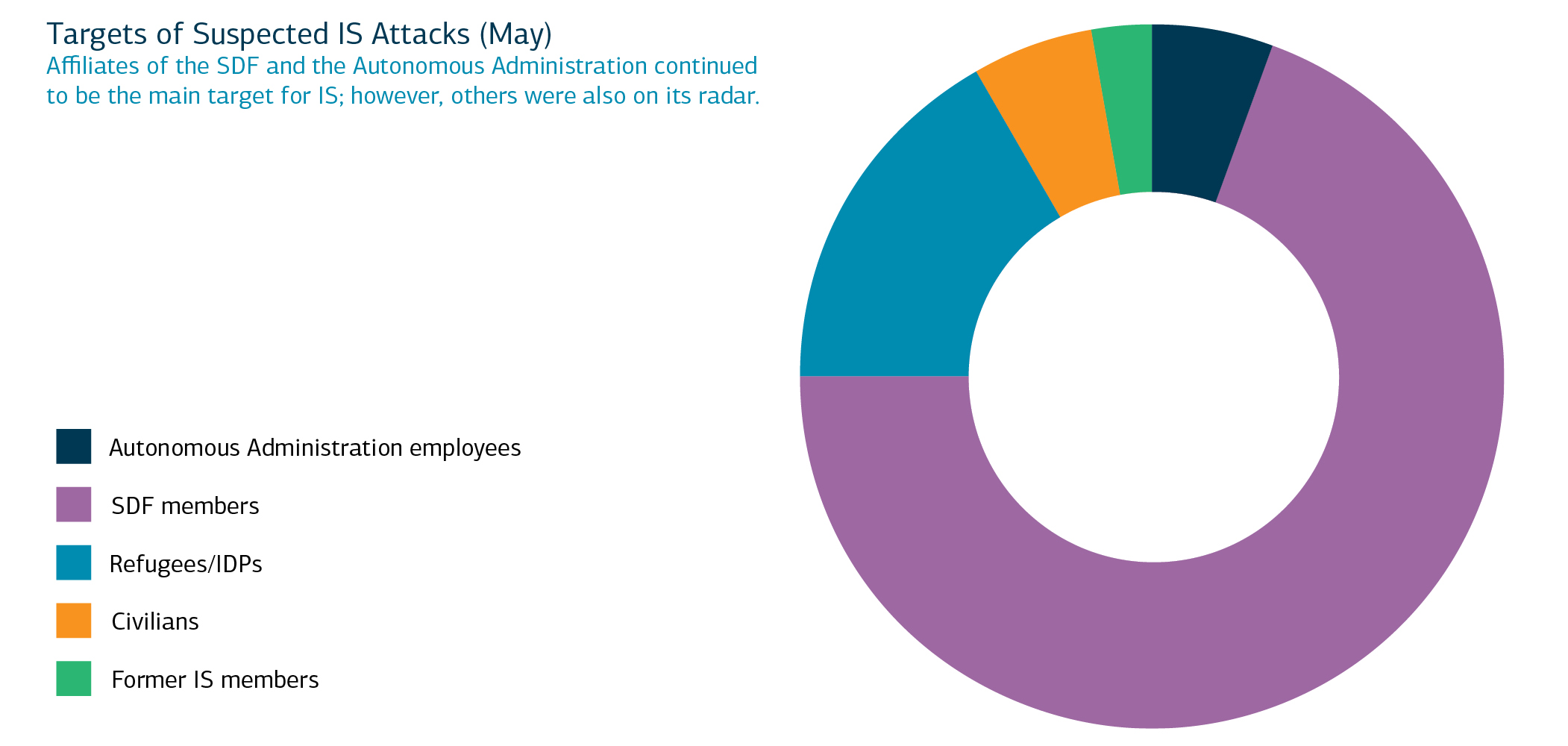
Over the month of May, the geographical reach of IS’s attacks expanded in eastern rural Deir-ez-Zor and southern rural Al-Hasakeh governorates (21 attacks, or 70 percent of IS attacks outside of al-Hol camp). Furthermore, IS seemingly restored its capacity to conduct operations inside al-Hol camp after a month’s hiatus following the conclusion of the large-scale security operation conducted by the SDF in April. At least six Iraqi refugees and Syrian IDPs were killed in eight separate attacks that took place in the camp in May. Notably, the town of Hole, which has heretofore been considered relatively safe, witnessed two attacks targeting SDF convoys. In parallel, the Autonomous Administration intensified its diplomatic efforts to repatriate foriegn residents, including Iraqis and Danes, from al-Hol camp, while the evacuation of Syrian IDPs to rural Deir-ez-Zor also continued.
In total, 69 percent of the attacks carried out in May targeted members of the SDF, killing 20, while the rest targeted civil employees of the Autonomous Administration, IDPs, and civilians. This is in contrast to March and April, when attacks exclusively targeted individuals affiliated with the SDF or the Autonomous Administration. However, attacks targeting civilians still account for only a small fraction of incidents in May. The reasons given for the attacks on civilians are worrying. For example, one person was killed in Elhisan for allegedly practising “witchcraft”. While IS is not expected to establish territorial control in the region any time soon, it seems eager to exploit any opportunity to solidify its social and ideological influence.
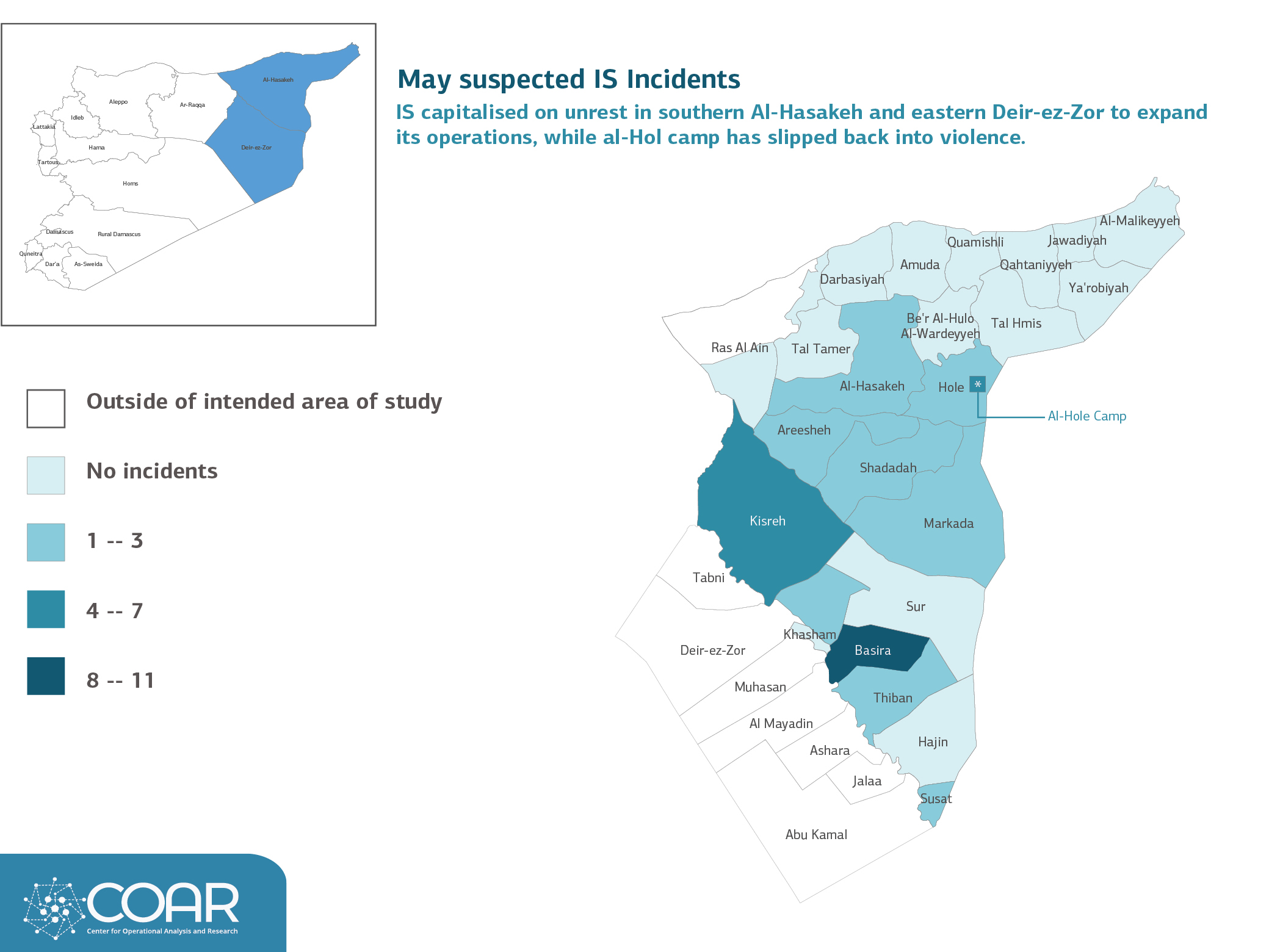
Beyond Eliminating IS’s capacity
The Autonomous Administration has continued to confront corruption within its own governance structures, IS insurgency, and smuggling along the Euphrates River in Deir-ez-Zor. Notably, following the defeat of the National Defence Forces in Quamishli in May, direct confrontation between the Autonomous Administration and the Government of Syria has temporarily subsided. Furthermore, as it becomes clear that stability remains elusive in al-Hol camp, the Autonomous Administration is taking further steps to accelerate the return process for Syrian IDPs and Iraqi refugees, and is intensifying diplomatic efforts with foreign governments to facilitate the repatriation of their citizens.
Between 10 and 20 May, the SDF carried out a series of military operations in Shiheil and surrounding towns, resulting in the arrest of around 48 individuals on the pretext that they were linked with IS. However, a few days after their arrest, at least half of the detainees were released in the absence of proof of any linkages or affiliation with IS. It is worth noting that just as Shiheil was among the Deir-ez-Zor communities where IS has the least direct influence, it is also among the major communities where the SDF is weakest. Due to its influential tribes (such as Al-E’keidat), the proliferation of weapons locally, and the preponderance of smuggling activities in the local economy, Shiheil has historically succeeded in preserving a degree of independence from the governorate’s controlling actors, which will create stablisiation challenges vis-à-vis regional governance actors, but also potential opportunities and entry points for implementation.
To bring the community to heel, the SDF utilises various methods including security raids, forced conscription, and cracking down on river smuggling routes, directly targeting smugglers, fishermen, and small boats. Resistance by the people of Shiheil has been on rise, particularly as smuggling is one of the main pillars of the local economy, and conscription deprives the local market of labour and weakens tribal structures. The Government of Syria is capitalising on the widening rift between the local community and the Autonomous Administration by allegedly supporting the creation of ‘popular resistance groups’ although actual groups operating along these lines have not yet emerged in the area.
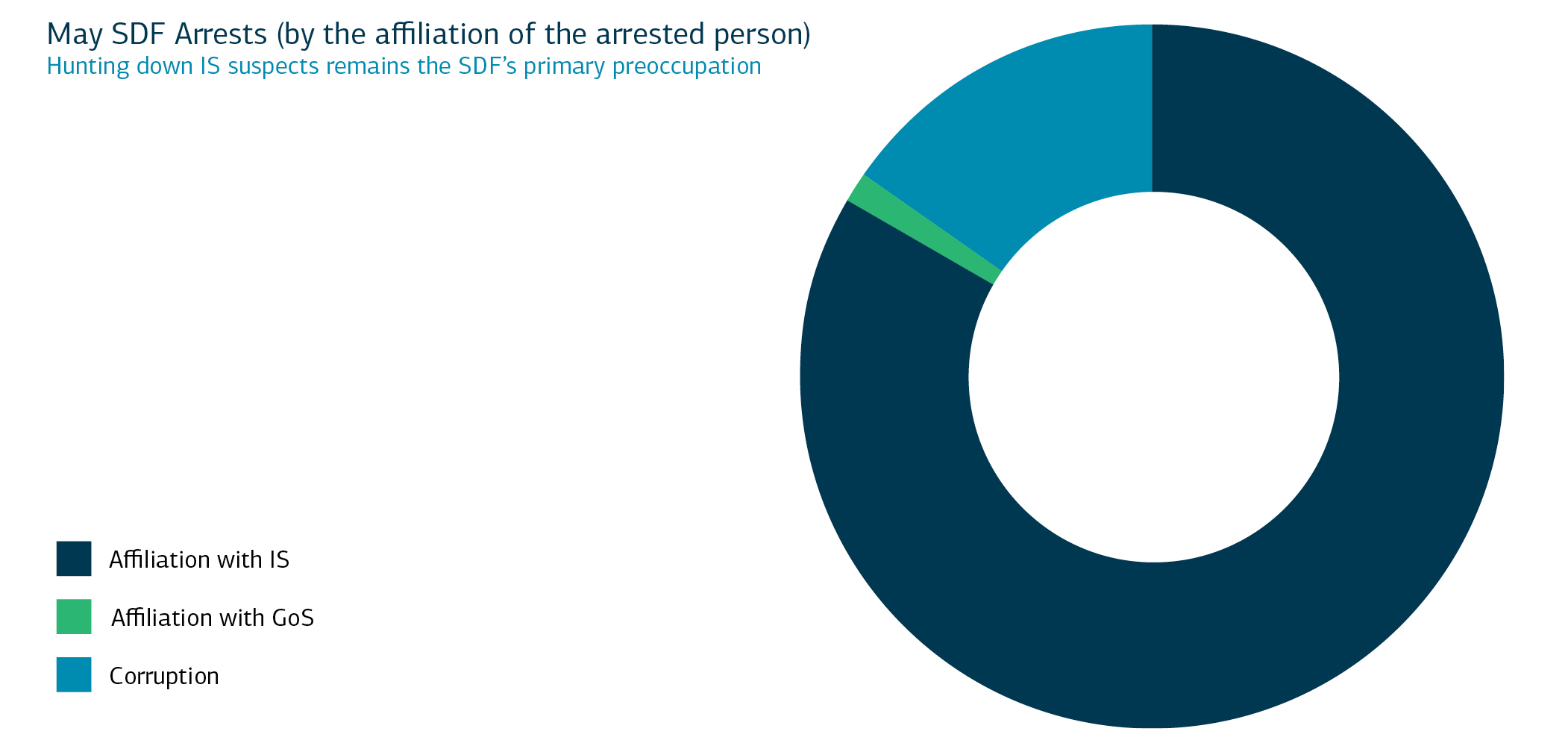
Incident Orientation
As in March and April, vertical events continued to be predominant in the majority of districts, especially in Deir-ez-Zor and Al-Hasakeh districts. Vertical events, primarily incidents where local communities challenged the Autonomous Administration’s decisions or resistance to SDF security attacks, comprise almost 65 percent of the total (133). Horizontal events — primarily comprising meetings between the Autonomous Administration and foreign delegates, joint patrols between international controlling actors, and social tensions based on familial or personal disputes — account for roughly 35 percent of the recorded incidents. Horizontal events were mainly recorded in Quamishli, Al-Hasakeh and Al-Malikeyyeh.
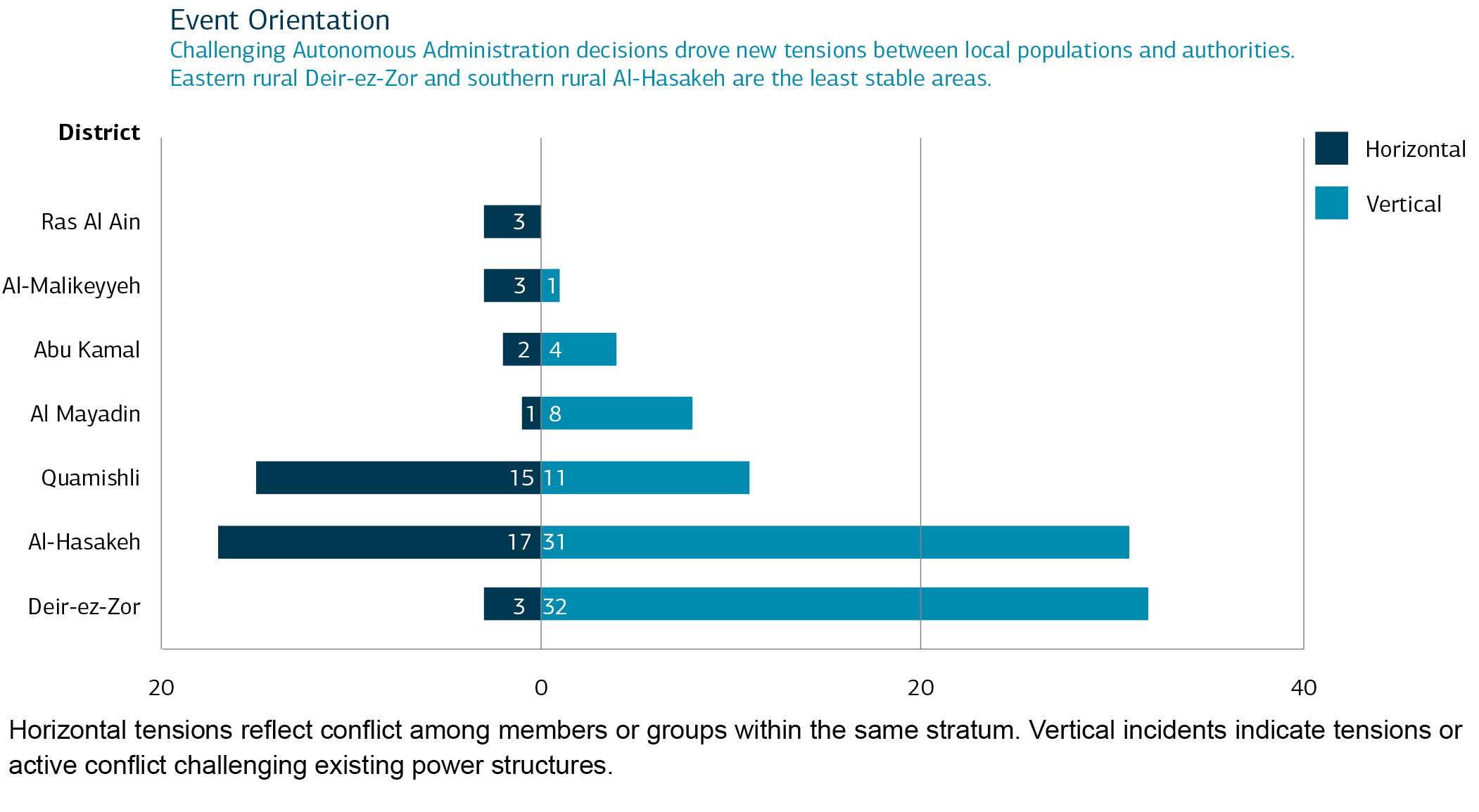
Horizontal tensions reflect conflict among members or groups within the same stratum. Vertical incidents indicate tensions or active conflict challenging existing power structures.
Key Findings: Searching for Stability in the Northeast
Analysing security and social incidents over a three-month period in northeast Syria brings to light a number of salient issues that have a major impact on stability in the region. It is worrying that the two governorates under analysis, al-Hasakeh and Deir-ez-Zor, now face deeper unrest and more volatile conditions than at any time since the defeat of the Islamic State, despite donors’ widespread interest in supporting stabilisation efforts there. Although donors and aid implementers must remain sensitised to the continually evolving conditions, several factors and challenges must be addressed.
- From a purely security and military perspective, IS is by far the most significant destabilising force in northeast Syria. The organisation has shown a growing capacity to adapt to changing military, security, and social realities. International efforts to prevent, slow, or undo the group’s resurgence must be seen as a precursor for any wider stabilisation activities.
- Poor services, the deteriorating economy, and growing unemployment rates are fuelling grievance and resistance to the Autonomous Administration, which has manifested in expressions of popular resistance such as protests and strikes, and in concerted efforts by local actors to attain greater operational independence. International donors are uniquely positioned to lend support to long-term efforts to build up the holistic resilience of key service sectors, but they must beware of operating in a way that links them too closely or publicly with the Autonomous Administration, which has an extremely negative reputation in many key programming areas.
- Water is one of the main factors driving instability in the region, due to its centrality in all facets of the predominantly agriculture-based economy. The drop in the level of the Euphrates River, the decline in rainfall, and the mismanagement and overexploitation of wells pose a threat of recurrent drought. Prioritisation of improved water management approaches, more favourable regional water-use procedures, and support designed to prevent water shortages from kicking off chain reactions in livelihoods and other sectors will be important to containing the impact of the region’s hostile hydropolitics.
- Corruption of local governance entities belonging to the Autonomous Administration, forced conscription, and feelings of marginalisation and lack of political representation, especially among Arab-majority communities, are among the main factors diminishing the legitimacy of the Autonomous Administration. International actors with leverage over the Autonomous Administration should prioritise advocacy to improve outcomes in these key areas.
- Arab tribes have divergent roles within their areas of influence. Although they are among the most important actors mobilising against the Autonomous Administration and bolstering the independence of their communities from local authorities, they are also essential to containing and mediating local disputes. More opportunities should be created for tribes to play the latter role, in response to the needs created by the former.
- Arab-Kurdish sensitivities have not been a direct cause of community conflict during the period of the study. However, these sensitivities have proven ripe for exploitation and in-group mobilisation, especially when coupled with feelings of inequality and marginalisation. Factors such as social perception and historical marginalization should be considered in area and project selection, alongside conventional needs criteria, particularly where donor objectives include fostering broader stability.
- The struggle by national and international actors over influence and resources is a destabilising factor. These struggles range from direct military confrontations to the politicisation of service provision and natural resources to enforcing restrictions on locals’ mobility and access to humanitarian aid.
Methodology
Geography
This report concerns data collected in May 2021 from Al-Hasakeh and Deir-ez-Zor governorates. The portion of Deir-ez-Zor that lies outside the control of the SDF and is, therefore, beyond the reach of most donor-funded activities, is excluded. Moreover, al-Hol camp is assessed as a standalone geography due to its unique status and the contrast between incidents observed there and in the surrounding Al-Hasakeh countryside. The incidents recorded are verifiable physical incidents.
Classifications
Two local field researchers based in Al-Hasakeh and Deir-ez-Zor governorates collected incident data directly and through their personal networks of local sources and field observers. In conjunction with these researchers, COAR has analysed incidents and classified them on a preliminary basis in several ways. In addition to basic information regarding actor identity and geography, they have been grouped according to a set of broad thematic categories. Most importantly for the purpose of assessing stability, COAR has classified incidents according to their directionality vis-à-vis local social and power dynamics. Incidents that reflect tensions within or between social groups of roughly equivalent power or standing are classified as having a horizontal direction. By contrast, incidents that reflect tension or conflict between local actors and formal or de-facto authorities or power structures are classified as being vertical in nature.





